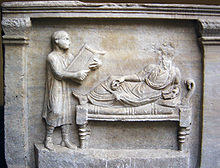Amanuensis
Eric Fenby acted as such in assisting the blind and paralysed composer Frederick Delius in writing down the notes he dictated.
Amanuenses were typically Greek, might be either male or female,[6] and were among the higher-status slaves in ancient Rome who were considered to add value[7] to their masters' lives rather than serving as mere instruments of production.
[10] One question in studies of the Christian mystic Margery Kempe, not known to have received a formal education, is the extent to which her amanuenses shaped her self-titled book, completed in 1438.
[12] An amanuensis might bring literary polish to visionary experience, as Adam of Eynsham, for instance, is thought to have drawn on the underworld book of the Aeneid to shape the "rather rambling and confused" visions of his brother Edmund.
For example, Petrus of Alvastra (aka Peter Olafsson) wrote down the visions of Bridget of Sweden as she recounted them in Swedish, and then translated them into Latin.

